当代物流学(第7讲)
现代物流学第七章PPT
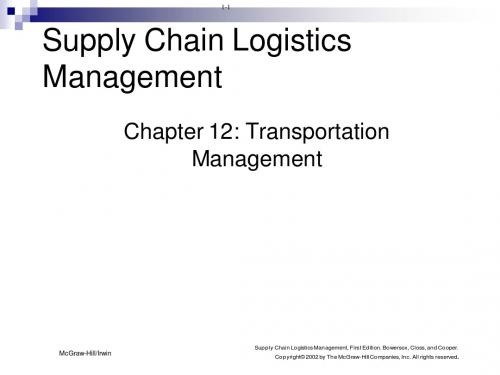
1-6
Rates and Rating
Class rates (分类,根据目的地确定费率) Classification Rate administration Minimum charge Surcharge Special rates and services
McGraw-Hill/Irwin
1-5
Carrier Pricing Strategies
Cost-of-service Value-of-service Combination Pricing
McGraw-Hill/Irwin
Supply Chain Logistics Management, First Edition. Bowersox, Closs, and Cooper. Copyright© 2002 by The McGraw-Hill Companies, Inc. All rights reserved.
1-15
Freight Control
Tracing Locate lost or late shipments Expediting notify a specific shipment move without delay
McGraw-Hill/Irwin
Supply Chain Logistics Management, First Edition. Bowersox, Closs, and Cooper. Copyright© 2002 by The McGraw-Hill Companies, Inc. All rights reserved.
1-1
Supply Chain Logistics Management
当代物流学(第九版)第7单元教学ppt
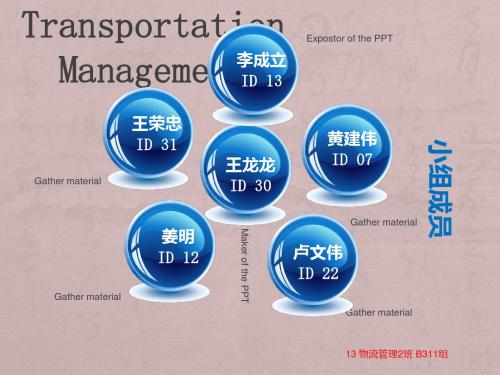
Freight Payment and Audit Services
Routing
01
02
03
04
Diversion occurs when the shipper notifies the carrier, prior to arrival, of a change in destination
Reconsignment occurs when the shipper notifies the carrier, after arrival, of a change in destination
3 2 1
Expediting is rapidly moving a shipment through a carrier’s system
Both of these are less likely to be used today since shipments can be pinpointed en route and carriers provide better on-time performance
Tracing is the attempt to locate lost or late shipments ——Done by computer at no cos
1
2
3
Demurrage and Detention
Consolidating Small Shipments
01 02
Figure 7-13: The Transportation Manager Consolidates Shipments Whenever He or She Can
That is all Thank you
现代物流学 PPT课件

装卸搬运概述
• 装卸搬运的概念 装卸:是指物流在指定地点以人力或机械 装入运输设备或卸下;(垂直移动) 搬运:是指在同一场所内,对物品进行以 水平移动为主的物流作业; 广义的装卸则包括了搬运活动;
47
装卸搬运概述
• 装卸搬运的地位 在物流活动中,装卸活动是不断出现和反 复进行的,它的频率高于其他各项物流活 动。
▲ 1.3.1 物流合理化的含义 1.3.2 物流合理化的作用
▲ 1.3.3 物流合理化的四种模式
33
1.3 物流合理化
▲物流合理化的含义
• 物流合理化 物流合理化是指设备配置和一切活动趋于 合理化的物流过程。
• 如何处理好降低物流成本与提高服务水平 的关系就是合理化物流的过程
34
1.3 物流合理化
者结合才能有效地实现商品由供方向需方 的转移过程。两者关系密切,相辅相成。
19
1.1 现代物流概述 现代物流与流通
• 商流与物流的关系 (2)商物分离
20
1.1 现代物流概述
现代物流与流通
• 商流与物流的关系 (2)商物分离的优点
缓和交通拥挤;仓库规模大,物流作业集 中;回路配送,提高运输水平,降低运输 费用;职能单纯化,提高工作效率;
包装合理化
• 包装的合理化原则 合理设置包装方式 (第一因素是考虑装卸;第二是考虑保管; 第三是考虑运输) 合理选用包装材料与技术 方便包装物回收利用,实现资源再循环
44
包装合理化
• 网络经济时代包装管理的发展趋势
45
物流活动构成
2.2 装卸搬运
▲ 2.2.1 装卸搬运概述 ▲ 2.2.2 装卸搬运合理化
现代物流学
1
目 录
Chapter 1 现代物流概述
当代物流学相关知识培训(英文版)(ppt 22页)

Allocating is breaking a homogeneous supply into smaller lots
Asserting is building up assortments of goods for resale, usually to retail customers
Two : the meaning of logistics
Clm : logistics is that point of the supply chain process that plans, implement, and controls the efficient ,effective forward and reverse flow and storage of goods, services, and related information between the point of origin and the point of consumption in order to meet customers’ requirement
Salvage and scrap dispose Transportation management Warehousing management
The most significant contribution that the logistics channel makes to the overall channel process is the sorting function, this function involves rearranging the assortment of products as they flow through the channels through the customer, taking large blocks of single products and rearranging them into quantities, assortments, and varieties that consumer prefer.
当代物流学(第16讲)

——总体讲,企业物流规划主要解决4个方 面的问题:1)客户服务目标:物流战略规 划的首要任务是确定适当的客户服务水平。 2)选址战略。3)库存战略。4)运输战略。
4.物流规划的思想基础
(1)物流规划是一项系统工程
物流系统是指在一定的时间和空间里,由 所需移动的物资、设备工具、仓储设施、人员 和通讯联系等若干相互制约的动态要素所构成 的具有特定功能的有机整体。和一般系统一样, 物流系统具有输入、转换及输出三大功能,通 过输入和输出使系统与社会环境进行交换,并 与环境相依存。
讨论:在什么条件下,第2方案优于第 1方案?
B地 超市
A地工厂
B地 超市
B地 超市
方案1
图1-1 两种物流系统方案比较
A地工厂
配送中心
方案2
B地 超市
B地 超市
B地 超市
2.物流规划的概念和分类
物流规划是在一定系统范围内对整个物 流体系建设进行总体的战略部署。研究确定 物流系统的发展方向、规模和结构,合理配 置资源,统一安排交通运输仓储等设施。
按照行业分类的不同,有军事物流规划、 农业物流规划、食品行业物流规划等。
(2)微观层面的物流规划:主要是从企业 物流运营的角度进行系统规划和优化,包括 消费者、生产者和流通企业所从事的、实际 的、具体的物流活动;也包括在整个物流活 动中局部的、一个环节的具体物流活动。
微观层面的物流规划主要包括3种类型:
3)支撑要素——是指建立物流系统所需 要的各种支撑手段,主要包括体制、制度, 法律、规章,行政、命令,组织及管理, 标准化系统等方面。
(4)物流系统的功能
物流系统的功能是指物流系统所具有的 物流服务基本能力,其相互结合、有效协 调,形成系统的总服务能力。一般认为物 流系统都拥有或部分拥有集货、运输(配 送)、储存、装卸搬运、包装、流通加工和 物流信息处理等功能。
现代物流学(完整版)
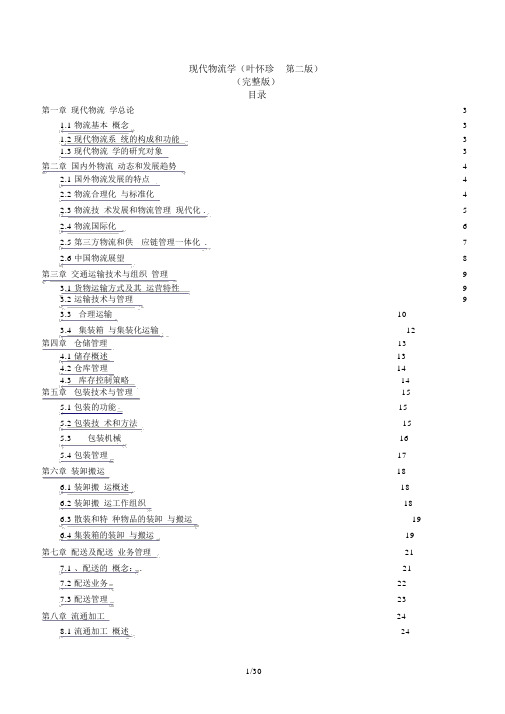
现代物流学(叶怀珍第二版)(完整版)目录第一章现代物流学总论 (3)1.1 物流基本概念 (3)1.2 现代物流系统的构成和功能 (3)1.3 现代物流学的研究对象 (3)第二章国内外物流动态和发展趋势 (4)2.1 国外物流发展的特点 (4)2.2 物流合理化与标准化 (4)2.3 物流技术发展和物流管理现代化 (5)2.4 物流国际化 (6)2.5 第三方物流和供应链管理一体化 (7)2.6 中国物流展望 (8)第三章交通运输技术与组织管理 (9)3.1 货物运输方式及其运营特性 (9)3.2 运输技术与管理 (9)3.3合理运输 (10)3.4集装箱与集装化运输 (12)第四章仓储管理 (13)4.1 储存概述 (13)4.2 仓库管理 (14)4.3库存控制策略 (14)第五章包装技术与管理 (15)5.1 包装的功能 (15)5.2 包装技术和方法 (15)5.3包装机械 (16)5.4 包装管理 (17)第六章装卸搬运 (18)6.1 装卸搬运概述 (18)6.2 装卸搬运工作组织 (18)6.3 散装和特种物品的装卸与搬运 (19)6.4 集装箱的装卸与搬运 (19)第七章配送及配送业务管理 (21)7.1 、配送的概念: (21)7.2 配送业务 (22)7.3 配送管理 (23)第八章流通加工 (24)8.1 流通加工概述 (24)8.2 流通加工形式与内容 (24)8.3 流通加工管理 (25)第九章物流信息系统 (26)9.1 物流信息及管理 (26)9.2 物流信息技术 (27)9.3 物流信息系统及其开发 (28)9.4 物流决策支持系统 (28)第十章物流中心网络概述 (30)10.1 物流中心与物流园区概述 (30)10.2 物流中心网络布局 (30)10.3 物流中心设计与投资的一般原则 (30)第十一章物流运输站(场)规划 (30)11.1 铁路货运站(场)规划 (30)11.2 公路货运站(场)规划 (30)11.3 水路货运码头规划 (30)11.4 航空货运港站规划 (30)11.5 管道输送站规划 (30)第十二章货物运输的优化求解 (30)12.1 产销运输问题 (30)12.2 分配运输问题 (30)12.3 网络流问题 (30)12.4 送货集货问题 (30)第一章现代物流学总论1.1 物流基本概念(一)物和流物:一切可以进行物理性位移的物质资料流:物理性移动(伴随的信息流动,资金流动)(二)物流的定义物流——物品从供应地向接收地的实体流动中,将运输、储存、装卸搬运、包装、流通加工、配送、信息处理等功能有机结合,优化管理来满足物主要求的过程。
当代物流学
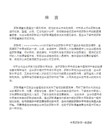
强势零售商往往掌握着比那些供应它们的公司更大的权力。
Many power retailers recognize superior logistics as an essential component of their corporate strategies.
Industrial distribution
Logistics
Logistics management
Materials management
Physical distribution
Supply chain management
Logistics: What It Is
(2) CSCMP definition:
职能内各物流活动相互依赖
Business logistics is made up of
Inbound logistics
内向物流
Materials management
物料管理
Physical distribution
实物配送
The Systems and Total Cost Approaches to Logistics
顾客行为的变化具有重要的物流意义。例如市场细分化、不断改变的家庭角色、不断增加的顾客期望等都具有其物流意义。
(3) Technological Advances
Technological Advances of Computer hardware, software and capacity facilitate logistical activities.
现代物流学概论(PPT 74页)

2020/11/15
12
3.2 80-20曲线 (The 80-20 Curve)
80-20曲线的概念源于帕累托法则 (Paratoo's Law)
产品类别总和(%)
18
ABC分类法
A类产品:起65%-80%作用却占15%-20%的物品
严格控制
B类产品:起15%-20%作用却占30%-40%的物品
正常控制
C类产品:起5%-15%作用却占40%-55%的物品
简单控制
80-20曲线概念决定了各种产品物流管理水平的差 异。
2020/11/15
7
451
89.1%
50.0%
8
412
91.9%
57.1%
9
214
93.6%
64.3%
10
205
95.1%
71.4%
11
188
96.4%
78.6%
12
172
97.6%
85.7%
13
170
98.7%
92.9%
14
159
① 13966
100.0
②
100.0
③
17
随后,根据得出的计算结果在坐标轴上绘出这些点:
Hale Waihona Puke 最广,会有很多存储点,产品
的现货供应比率也控制在较好
的水平上。
4. 衰退期:产品的销量下 为保持高效的配送,需调整产
降
品运输和存货调度的模式。存
储点将减少,产品库存将下降,
当代物流学摘要

第一章物流和供应链经济效用:是指产品在满足顾客的需要和需求上的价值或有用性。
四种经济效用:1)拥有效用;指的是能够拥有某产品的顾客所得到的价值或有用性。
2)形式效用:产品以一种形式存在,这时产品一方面可以被顾客使用,另一方面对顾客有价值。
3)地点效用:指在顾客需要的地方提供产品;产品被从较低价值的地点移动到较高价值的地点。
4)时间效用:是指当顾客需要的时候提供产品。
CSCMP(供应链管理专业协会)定义物流:物流是供应链管理的一部分,它以满足顾客需求为目标,对产品、服务和相关信息在起始点和消费点之间的有效率、有效果的正向和逆向流动和储存进行计划、实施和控制。
定义要点:1)物流是供应链管理的一部分。
2)指出物流进行计划、实施和控制。
3)有效率、有效果的正向和逆向流动和储存。
4)物流参与产品、服务和相关信息的流动储存。
5)物流的目的是满足顾客需求。
物流日益增长的重要性的原因:1)经济规制的放松;2)顾客行为的改变;3)技术进步;4)零售商权力不断增大;5)贸易全球化。
系统方法的寓意之一是主要职能部门的目的和目标必须与公司的目的和目标一致。
寓意之二是一个职能部门指定的决策应该考虑对其他部门的潜在影响。
最小存货单位(SKU)的增长意味着:1)更多的项目需要辨别;2)更多的项目需要储存;3)更多的项目需要跟踪。
总成本方法:是以成本效益的方式来协调内向物流、物料管理和实物配送。
公司内部的物流关系:(1)财务:库存是财务经理关心的一个领域,需要考虑的是评估库存的价值、财务上经常用美元成本或美元价值来衡量库存和库存浮动的因素。
库存浮动是指与持有库存相关的现金流。
(2)营销:1)地点决策可能也包含接近新顾客的新策略。
联合品牌优势:1 为潜在顾客提供便利;2 增加顾客一次消费中的花费;3 促进品牌意识。
2)价格决策物流系统中浪费严重的公司面临的选择:第一种是将较高的物流成本转嫁到顾客身上,因此提高产品价格。
第二种是保持价格不变,但是降低产品质量或数量,这会导致顾客流失。
小保罗·R·墨菲《当代物流学》习题辅导
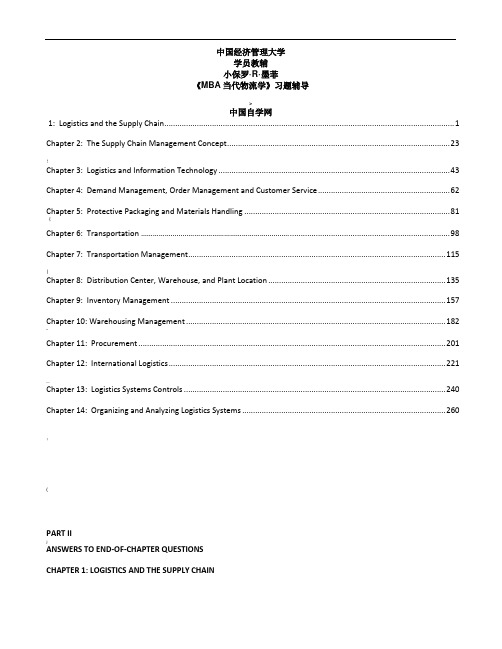
中国经济管理大学学员教辅小保罗·R·墨菲《MBA当代物流学》习题辅导>中国自学网1: Logistics and the Supply Chain (1)Chapter 2: The Supply Chain Management Concept (23)!Chapter 3: Logistics and Information Technology (43)Chapter 4: Demand Management, Order Management and Customer Service (62)Chapter 5: Protective Packaging and Materials Handling (81)《Chapter 6: Transportation (98)Chapter 7: Transportation Management (115)|Chapter 8: Distribution Center, Warehouse, and Plant Location (135)Chapter 9: Inventory Management (157)Chapter 10: Warehousing Management (182)-Chapter 11: Procurement (201)Chapter 12: International Logistics (221)…Chapter 13: Logistics Systems Controls (240)Chapter 14: Organizing and Analyzing Logistics Systems (260);(PART II;ANSWERS TO END-OF-CHAPTER QUESTIONSCHAPTER 1: LOGISTICS AND THE SUPPLY CHAIN1. Did it surprise you that logistics can be such an important component in a country’s economic system Why or why not它构成了一个国家至少10%的GDP、对于经济增长有很重要的作用The answer to this question likely depends on a student’s prior exposure to logistics. A “typical” student in an undergraduate basic logistics course likely has had limited exposure to and knowledge about logisticsand thus would likely be unaware as to logist ics’ impact on a country’s economic system. As such, she/hemight be pleasantly surprised to learn that logistics often accounts for at least 10% of a country’s GDP and also is important for economic growth and development.2.Distinguish between possession, form, time, and place utility.—Possession utility refers to the value or usefulness that comes from a customer being able to takepossession of a product and can be influenced by the relevant payment terms. Form utility refers to aproduct’s being in a form that (1) can be used by the customer and (2) is of value to the customer. Timeutility refers to having products available when they are needed by customers while place utility refers to having products available where they are needed by customers.3.How does logistics contribute to time and place utility时间效用:不同产品有不同的时间敏感度,香蕉和铅笔;地点效用:把产品从价至少的地方运到价值大的地方。
《现代物流学》讲稿
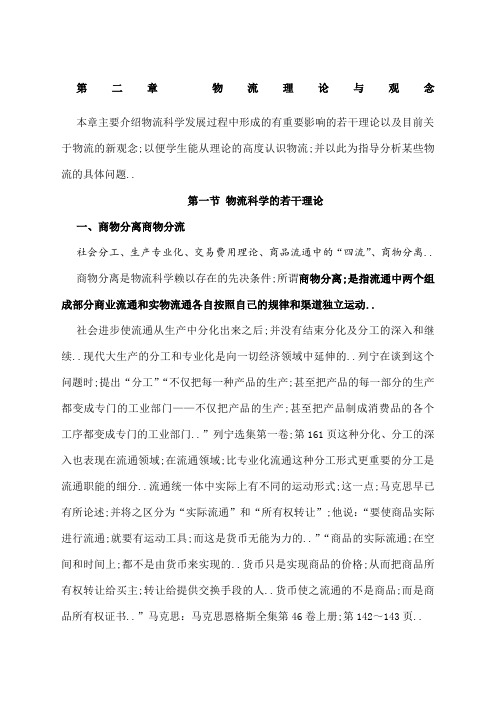
第二章物流理论与观念本章主要介绍物流科学发展过程中形成的有重要影响的若干理论以及目前关于物流的新观念;以便学生能从理论的高度认识物流;并以此为指导分析某些物流的具体问题..第一节物流科学的若干理论一、商物分离商物分流社会分工、生产专业化、交易费用理论、商品流通中的“四流”、商物分离..商物分离是物流科学赖以存在的先决条件;所谓商物分离;是指流通中两个组成部分商业流通和实物流通各自按照自己的规律和渠道独立运动..社会进步使流通从生产中分化出来之后;并没有结束分化及分工的深入和继续..现代大生产的分工和专业化是向一切经济领域中延伸的..列宁在谈到这个问题时;提出“分工”“不仅把每一种产品的生产;甚至把产品的每一部分的生产都变成专门的工业部门——不仅把产品的生产;甚至把产品制成消费品的各个工序都变成专门的工业部门..”列宁选集第一卷;第161页这种分化、分工的深入也表现在流通领域;在流通领域;比专业化流通这种分工形式更重要的分工是流通职能的细分..流通统一体中实际上有不同的运动形式;这一点;马克思早已有所论述;并将之区分为“实际流通”和“所有权转让”;他说:“要使商品实际进行流通;就要有运动工具;而这是货币无能为力的..”“商品的实际流通;在空间和时间上;都不是由货币来实现的..货币只是实现商品的价格;从而把商品所有权转让给买主;转让给提供交换手段的人..货币使之流通的不是商品;而是商品所有权证书..”马克思:马克思恩格斯全集第46卷上册;第142~143页..第二次世界大战之后;流通过程中上述两种不同形式出现了更明显的分离;从不同形式逐渐变成了两个有一定独立运动能力的不同运动过程;这就是所称的“商物分离”..“商”;指“商流”即商业性交易;实际是商品价值运动;是商品所有权的转让;流动的是“商品所有权证书”;是通过货币实现的;“物”即“物流”;即马克思讲的“实际流通”;是商品实体的流通..本来;商流、物流是紧密地结合在一起的;进行一次交易;商品便易手一次;商品实体便发生一次运动;物流和商流是相伴而生并形影相随的;两者共同运动;取同样过程;只是运动形式不同而已..在现代社会诞生之前;流通大多采取这种形式;甚至今日;这种情况仍不少见..商物分离形式如图所示;如果物流以本身的特殊性与商流过程分离;与和商流过程完全一致比较;显然要合理得多..商流和物流也有其不同的物质基础和不同的社会形态..从马克思主义政治经济学角度看;在流通这一统一体中;商流明显偏重于经济关系、分配关系、权力关系;因而属于生产关系范畴..而物流明显偏重于工具、装备、设施及技术;因而属于生产力范畴..所以;商物分离实际是流通总体中的专业分工;职能分工;是通过这种分工实现大生产式的社会再生产的产物..这是物流科学中重要的新观念..物流科学正是在商物分离基础上才得以对物流进行独立的考察;进而形成的科学..但是;商物分离也并非绝对的;在现代科学技术有了飞跃发展的今天;优势可以通过分工获得;优势也可以通过趋同获得;“一体化”的动向在原来许多分工领域中变得越来越明显;在流通领域中;发展也是多形式的;绝对不是单一的“分离”..事实上;有一些国家的学者和一些领域中的操作都提出了商流和物流在新基础上的一体化的问题;欧洲一些国家对物流的理解本来就包含企业的营销活动;即在物流研究中包含着商流..在物流的一个重要领域——配送领域中;配送已成了许多人公认的既是商流又是物流的概念;企业中;最初是把独立设置物流部门看成一种进步;而现在;则更多地进行综合的战略管理;而不单独分离其功能;这也是值得我们重视的..二、第三个利润源说降低物质材料消耗的第一利润源;节约活劳动消耗的第二利润源;降低物流成本的第三利润源;实例说明..“第三个利润源”的说法主要出自日本..“第三个利润源泉”;是对物流潜力及效益的描述..经过半个世纪的探索;人们已肯定这“黑大陆”虽不清;但绝不是不毛之地;而是一片富饶之源..尤其是经受了1973年石油危机的考验;物流已牢牢树立了自己的地位;今后的问题是进一步开发了..从历史发展来看;人类历史上曾经有过两个大量提供利润的领域..第一个是资源领域;第二个是人力领域..资源领域起初是廉价原材料、燃料的掠夺或获得;其后则是依靠科技进步;节约消耗、节约代用、综合利用、回收利用乃至大量人工合成资源而获取高额利润;习惯称之为“第一个利润源”..人力领域最初是廉价劳动;其后则是依靠科技进步提高劳动生产率;降低人力消耗或采用机械化、自动化来降低劳动耗用从而降低成本;增加利润;这个领域习惯称作“第二个利润源”..在前两个利润源潜力越来越小;利润开拓越来越困难情况下;物流领域的潜力被人所重视;按时间序列排为“第三个利润源”..这三个利润源注目于生产力的不同要素;第一个利润源的挖掘对象是生产力中劳动对象;第二个利润的挖掘对象是生产力中的劳动者;第三个利润源则主要挖掘生产力要素中劳动工具的潜力;与此同时又挖掘劳动对象和劳动者的潜力;因而更具有全面性..第三个利润源的理论最初认识是基于两个前提条件:第一;物流是可以完全从流通中分化出来;自成一个独立运行的;有本身目标;本身的管理;因而能对其进行独立的总体的判断;第二;物流和其他独立的经营活动一样;它不是总体的成本构成因素;而是单独盈利因素;物流可以成为“利润中心”型的独立系统..第三个利润源的理论;反映了日本人对物流的理论认识和实践活动;反映了他们与欧洲人、美国人的差异..一般而言;美国人对物流的主体认识可以概括为“服务中心”型;而欧洲人的认识可以概括为“成本中心”型;显然;“服务中心”和“成本中心”的认识和“利润中心”的差异很大..“服务中心”和“成本中心”主张的是总体效益或间接效益;而“第三个利润源泉”的“利润中心”的主张;是指的直接效益..但是如果广义理解“第三个利润源”把“第三个利润源”不仅看成直接谋利手段;而特别强调它的战略意义;特别强调它是在经济领域中潜力将尽的情况下的新发现;是经济发展的新思路;也许会对今后经济的推动作用真正如同经济发展中曾有的廉价原材料的推动作用一样;这恐怕是现在学术界更多人的认识;“第三利润源”的真正价值恐怕是从直接利润演伸的战略意义了..三、黑大陆与物流冰山说流通是经济领域的黑暗大陆;其中物流活动的模糊性尤其突出..可见物流费用、不可见物流费用、物流冰山..着名的管理学权威P.F. 德鲁克曾经讲过:“流通是经济领域里的黑暗大陆”;德鲁克泛指的是流通;但是;由于流通领域中物流活动的模糊性尤其突出;是流通领域中人们更认识不清的领域;所以;“黑大陆”说法现在转向主要针对物流而言..“黑大陆”说法主要是指尚未认识;尚未了解;在黑大陆中;如果理论研究和实践探索照亮了这块黑大陆;那么摆在人们面前的可能是一片不毛之地;也可能是一片宝藏之地..“黑大陆”说是对二十世纪中在经济界存在的愚昧的一种反对和批判;指出在当时资本主义繁荣和发达的状况下;科学技术也好;经济发展也好都远未有止境;黑大陆说也是对物流本身的正确评价:这个领域未知的东西还很多;理论和实践皆不成熟..在某种意义上来看;“黑大陆”说是一种未来学的研究结论;是战略分析的结论;带有很强的哲学的抽象性;这一学说对于研究这一领域起到了启迪和动员作用..物流冰山说是日本早稻田大学西泽修教授提出来的;他专门研究物流成本时发现;现行的财务会计制度和会计核算方法都不可能掌握物流费用的实际情况;大家只看到物流费用露出海水上面的冰山的一角;而潜藏在海水里的整个冰山却看不见;海水中的冰山才是物流费的主体部分..一般情况下;企业会计科目中;只把支付给外部运输、仓库企业的费用列入成本;实际这些费用在整个物流费用中确实犹如冰山的一角..因为;物流基础设施建设费和企业利用自己的车辆运输、利用自己的库房保管货物、由自己的工人进行包装、装卸等等费用都没列入物流费用科目内..一般来说;企业向外部支付的物流费是很小的一部分..真正的大头是企业内部发生的物流费..“物流费用冰山”说之所以成立;有三个方面的原因..一是物流成本的计算范围大大..包括:原材料物流、工厂内物流、从工厂到仓库和配送中心的物流、从配送中心到商店的物流等..这么大的范围;涉及的单位非常多;牵涉的面也很广;很容易漏掉其中的某一部分;计算哪部分;漏掉哪部分;物流费用的大小相距甚远..二是运输、保管、包装、装卸、以及信息筹备物流环节中;以哪几种环节作为物流成本的计算对象问题..如果只计运输和保管费用;不计其他费用;与运输、保管、装卸、包装以及信息等费用全部计算;两者的费用结果差别相当大..三是选择哪几种费用列入物流成本中的问题..比如..向外部支付的运输费、保管费、装卸费等费用一般都容易列入物流成本;可是本企业内部发生的物流费用;如与物流相关的人工、物流设施建设费、设备购置费;以及折旧费、维修费、电费、燃料费等是否也列入物流成本中此类问题都与物流费用的大小直接相关..因而我们说物流费确实犹如一座海里的冰山;露出水面的仅是冰山的一角..美国和日本的物流费用是很高的;估计我国的物流费在销售额中所占的比例还要高..既使按日本最保守的算法计算;比如;当一个企业销售额为1000亿日元时;物流成本占销售额10%的话;就是100亿日元..这就意味着;只要降低10%的运输、保管、装卸、包装筹备环节的物流费;就等于增加10亿日元的利润..假如这个企业的销售利润率为2%创造10亿日元的利润;需要增加500亿日元的销售额..这会是很困难的;但降低10%的物流费与此相比却容易办到..同时也可以说;降低10%的物流费用所起的作用;相当于销售额增加50%..西泽修先生用物流成本的具体分析论证了德鲁克的“黑大陆”说;事实证明;物流领域的方方面面对我们而言还是不清楚的;在黑大陆中和冰山的水下部分正是物流尚待开发的领域;正是物流的潜力所在..四、效益背反说和物流的整体观念物流功能要素间的损益矛盾;物流森林;追求整体效果..“效益背反”是物流领域中很经常的很普遍的现象;是这一领域中内部矛盾的反映和表现..效益背反指的是物流的若干功能要素之间存在着损益的矛盾;也即;某一个功能要素的优化和利益发生的同时;必然会存在另一个或另几个功能要素的利益损失;反之也如此..这是一种此涨彼消;此盈彼亏的现象;虽然在许多领域中这种现象都是存在着的;但物流领域中;这个问题似乎尤其严重..效益背反说有许多有力的实证予以支持;例如;包装问题;在产品销售市场和销售价格皆不变的前提下;假定其他成本因素也不变;那么包装方面每少花一分钱;这一分钱就必然转到收益上来;包装越省;利润则越高..但是;一旦商品进入流通之后;如果简省的包装降低了产品的防护效果;造成了大量损失;就会造成储存;装卸、运输功能要素的工作劣化和效益大减;显然;包装活动的效益是以其他的损失为代价的;我国流通领域每年因包装不善出现的上百亿的商品损失;就是这种效益背反的实证..单纯认识物流可以具有与商流不同特性而独立运动这一点;是物流科学走出的第一步;在认识效益背反的规律之后;物流科学也就迈出了认识物流功能要素这一步;而寻求解决和克服各功能要素效益背反现象;当然;或许也曾有过追求各个功能要素全面优化的企图;但在系统科学已在其他领域形成和普及的时代;科学的思维必将导致人们寻求物流的总体最优化..不但将物流这一黑大陆细分成若干功能要素来认识物流;而且将包装、运输、保管等功能要素的有机联系寻找出来;成为一个整体来认识物流;进而有效解决“效益背反”;追求总体的效果见图;这是物流科学的一大发展..这种思想在不同国家;不同学者中的表述方法是不同的;例如美国学者用“物流森林”的结构概念来表述物流的整体观点;指出物流是一种“结构”;对物流的认识不能只见功能要素而不见结构;即不能只见树木不见森林;物流的总体效果是森林的效果;即使是和森林一边多的树木;如果各个孤立存在;那也不是物流的总体效果;这可以归纳成一句话:“物流是一片森林而非一颗颗树木”..参见图..对这种总体观念的描述还有许许多多的提法;诸如物流系统观念;多维结构观念;物流一体化观念;综合物流观念;后勤学和物流的供应链管理等都是这种思想的另一种提法或者是同一思想的延伸和发展..五、后勤说后勤工程学说后勤说的中心着眼于消费者;强调准确无误、绝对保障;是企业的战略举措;后勤活动的具体内容..后勤的来源在经济界使用后勤Logistics一词;是第二次世界大战以后的事..美国从本世纪六十年代开始;逐渐用Logistics一词取代了Physical distribution一词;七十年代后勤一词引进日本;日本同样翻译成“物流”;但是却按新的解释来解释;也即赋与了物流一定新的含义..在美国为什么先使用实物分销一词;尔后又称之为后勤呢这需要从发达国家的特定环境来考察..美国等西方国家本世纪便进入了所谓的买方市场经济;除了第二次世界大战和战后一段时间的管制和配给以外;本世纪经济发展的主要环境是买方市场环境..在买方市场环境;卖方处于竞争状态而买方主动权颇大;是属于买易卖难的市场环境;因此;研究自然集中于卖;也即集中于销售;实物分销一词自然就出现在销售学或市场学之中;所以;西方原来对物流的研究;也即对实物分销的研究;在整个经济活动中是销售活动的范畴;实物分销一同自然反映了这一客观现实..欧美等国将实物分销改称为后勤;不是无缘无故地改称;而是这一经济形态的实际内容确实发生了变化..原来集中于销售领域的活动;在这门科学越来越形成;经济活动实践越来越深入之后;发现局限性太大了;经济理论研究和经济活动的实践都证明;这一领域效益的取得;单在销售领域是不行的;必须有更大的系统和更强的综合战略;也即;德鲁克讲的“黑大陆”不仅存在于销售领域;同样也存在生产和产前的供应领域;必须按这更广泛的领域建立新的概念..后勤的概念便是这样一个概念;它不仅包含了企业产后的实物分销的营销领域;而且还包括了企业产前的供应领域;如图所示..美国后勤管理协会对企业后勤的定义是:“企业为了满足客户的要求;在使原材料、半成品、成品和相关信息在原产地和消费地之间实现高效且经济的运输和储存过程中必须从事的计划;实施和控制等全部活动..”所以;可以明显看出;后勤和实物分销的区别在于;前者在后者基础上有了延伸和扩展;但本质是相同的;当然;也不能小视这一延伸和扩展;这是建立在现代科学技术手段可以实现对这一延伸扩展的控制的基础上;是建立在比以前更大的信息系统有可能变为现实的基础上;是建立在能管理和协调这么大的系统的基础上;所以本质虽同;水平却有时代的差别..我国学术界的看法我国学术界现在的看法不一;一般将英文的实物分销Physical distribution 和后勤Logistics都译成物流;并仍使其保留原来物流的主要含义和全部结构;至于对物流理解的变化;即使没有两个词汇的翻译问题;也必然是变化和发展的..但是;也有些学者主张物流与后勤作为这门科学两个时代的词汇标志;在翻译上应有所区分..由此引发的问题是;国外用“logistics”取代了“physical distribution”;而我们的译法是否也应随之变化;即由物流改为后勤对此我的几点想法是:第一;狭义的“physical distribution”的确曾被译作物流;这里的物流是狭义的产成品物流..然而问题在于;汉语中物流一词的含义原本宽于狭义的“physical distribution” ..因此;当国外用含义更为宽泛的“logistics”取代狭义的“physical distribution”时;我们可仍用物流一词;取其广义;而实现由产成品物流狭义物流向综合物流广义物流的转换..第二;更为重要的一点是;随着“logistics”一词在国外被愈加广泛地使用;该词本身的含义也已发生了变化;原始的“logistics”一词指军事单位向自身提供装备和给养..这相当于企业中的“materials management”或“materials supply”即企业物资供应与管理;这一含义的确对应于汉语中后勤一词..而现时已在国外被广泛使用着的“logistics”一词;不仅包括向企业本身提供物资的入厂物流..而且还包括企业向用户送交产成品的出厂物流..这便意味着“logistics”一词的含义在国外已不仅仅是汉语中后勤一词所对应的内容;而是已经发生了扩展..而且;其新的含义又基本对应于我们的广义物流..当外文词汇的含义发生了变化时;用新的汉语词汇进行翻译;要优于延用原来的对应汉语词汇进行翻译;同时要求这一汉语词汇本身的含义也随之发生变化..对于“logistics”一词;如果我们仍用后勤一词翻译;那我们便必须要求汉语中后勤一词的词义也随着英文;由内部供给扩展为包括对外供应的企业综合物流..这是非常不方便的;也是没有必要的..第三;同运输、配送等词汇一样;后勤一词是动作性词汇;而物流一词从字面上讲只是描述了物品流动的客观状态..从这一角度讲;后勤可以比物流更好地反映人们进行的物流作业及管理活动的动作性或行为性特征;这可能也是国外使用“distribution”或“logistics”这样的动作性词语;而不使用对应于我国“流通”的“goods flow”和“materials flow”这样的描述物体流动的客观状态性词语的原因所在..这里值得注意的是:一方面;如前面所述;同商品流通一样;“物流”一词在我国已经被公认隐含地包含了人们对物体流动的运作及管理活动;另一方面更为重要的是;“后勤”一词原本的内部供应含义具有其内在的局限性;因此;对于“logistics”;“物流”仍旧是比“后勤”一词更为妥当的译法..当然;我们在使用“物流”一词时;仍应当意识到它的上述缺陷;在必要时以物流作业和物流管理这类动作性词汇强调人们的物流行为或活动..第四;将“logistics”一词译为“物流”;并不意味着两者含义的完全等同..一般而言;“logistics”一词在国外基本上表示以企业为本位的企业综合物流;而汉语中“物流”一词的含义则更为宽广..而且;“物流”一词在我国的使用也有愈加泛化的趋势..这种趋势反映了各种社会物流职能相互渗透;相互融合;以及对各种物流职能进行一体化管理的要求..然而;在一些特定的场合;还是应当注意对各种不同物流职能加以区分..以物流的综合性否定备种传统物流职能的相对独立性和特殊性是不妥当的..物流已经成为一个多层面的、内容十分丰富的概念..我们在使用这一概念时应注意到它在不同场合所代表的不同含义..第五;当然;深入追循;还会有许多差别..日本早稻田大学教授阿保荣司认为;日本的物流观念与美国后勤观念主要区别在于;日本的物流是着眼于企业;着眼于流通;所以才强调是企业“第二个利润源泉”..而美国的后勤;中心点着眼于消费者;后勤的一切活动都是在满足消费者而不是满足企业自己的基础上;所以美国根本不谈第三个利润源泉而特别强调后勤保证..采用原来用于军事领域的后勤一词;就是特别强调对用户保障的严重性和严肃性;要象军事活动那样准确无误;象军事活动那样计划周密和绝对保障..所以;后勤的思想更具有战略性而不着眼于既得之利益;是企业发展的战略举措而不是一时谋取利润的手段方法..因此它不是一项单纯性的职能活动;而是企业制定经营战略的上项基本原则..更可以理性他讲:后勤是一种思维方式;按这观念可以建立起企业新的管理模式..后勤学的内涵表述与本书详述之现代物流学是基本一致的;这里就后勤学若干基本点简述如下:后勤网络的基本实体要素主要有原料产地、制造工厂、配送中心和客户..后勤活动的具体内容包括14个方面:1客户服务;2订单处理;3配送联络;4存货控制;5需求预测;6交通和运输;7仓库和储存;8工厂和仓库布局选地;9物料搬运;10物料采购;11备件和维修服务保障;12工业包装;13退货处理;14废弃物处理;六、物流的供应链管理物流科学一形成便给这一个科学领域注入了系统的思想;这是毫无疑义的;因为;分散的功能要素集合成一个物流系统;这是物流的根本意义所在..但是有系。
当代物流学讲义(PPT 69页)
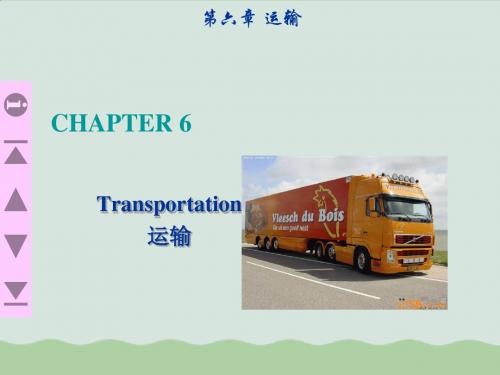
Electronic or electrical equipment 电器产品,印刷品,
Printed matter
机器及零件,采摘 的鲜花和幼苗,汽
Machinery and parts
车零配件,水果和
Cut flowers and nursery stock
蔬菜,金属制品,
Auto parts and accessories
第六章 运输
CHAPTER 6
Transportation 运输
第六章目第录六章 目录
第一节 运输模式
CONTENTS OF CH第A二P节T航E空R运6输
第三节 汽车运输
Section Section
1 2
Transportation Airfreight
第M四od节es
管道运输
ห้องสมุดไป่ตู้
Section 3 Motor Carriers第五节 铁路运输
transportation specialists 4.了解各种规制及其对运输的 4. To learn about different t影yp响es of regulation and
their influence on transport5a.ti懂on得承运人的法定分类
5. To understand the legal c6la.s认sif识ica国ti与on国of之ca间rr不ier同s 的运输 6. To appreciate that differe基nt础co设un施tr及ies不h同av规e 制
类 Topology 拓扑,布局 Macroenvironmental 宏观环境的 International transportation 国际运输 Paved runways 铺设的跑道 Accommodate 容纳,提供 Wide-body aircraft 宽体飞机
现代物流学-第7章
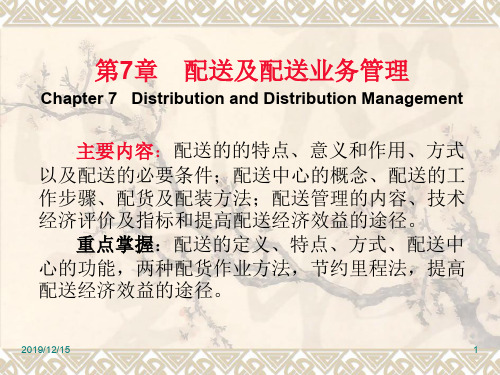
2019/12/15
14
7.2.1.1 配送中心的基本功能
1、备货 备货是配送的准备工作或基础工作,
包括筹集货源、订货或购货、集货、进货及 有关的质量检验、结算、交接等。
2019/12/15
32
PAB C D E F G H I
P
11 10 9 6 7 10 10 8 7
A
5 10 14 18 21 21 13 6
B
5 9 15 20 20 18 11
C
4 10 19 19 17 16
D
6 15 16 14 13
E
9 17 15 14
F
14 18 17
G
12 17
2019/12/15
30
(0.9)
C
(1.1)
(1.2)
D
6
(1.6) E
7 9
10
F
10 14
G
(0.9)
4 7
6 5
P
12
5 4
5 8
11
B (0.5)
5
A (1.7)
6 3
4
I (0.6)
5
7
H
(0.9)
2019/12/15
某配送中心配送网络图
31
计算配送中心至各用户以及各用户之间 的最短距离,列表得最短距离表:
3、应有齐备的配送设施和设备:特别是运 输设备,在车型、载重量、载重总吨位等方面有 更高的要求。
4、应有高效的信息系统
- 1、下载文档前请自行甄别文档内容的完整性,平台不提供额外的编辑、内容补充、找答案等附加服务。
- 2、"仅部分预览"的文档,不可在线预览部分如存在完整性等问题,可反馈申请退款(可完整预览的文档不适用该条件!)。
- 3、如文档侵犯您的权益,请联系客服反馈,我们会尽快为您处理(人工客服工作时间:9:00-18:30)。
Minimum travel Space utilization Ergonomics Energy Ecology Mechanization
5-16
Materials Handling Principles
Automation Flexibility Simplification Gravity Safety Computerization
and recycle it
5-6
Packaging
Protective functions of packaging
Enclose materials Restrain materials from undesired movement Separate contents to prevent undesired contact Cushion contents from outside vibrations and shocks Support the weight of identical containers stacked above Position the contents to provide maximum protection Provide for uniform weight distribution Provide exterior surface for labeling Be tamperproof Be safe for consumers or others
5-14
Materials Handling
Materials handling refers to how the materials or products are handled physically
How the products are handled depends on whether they are packaged or in bulk
Disadvantages
Provides large quantity that sometimes is of limited value to resellers dealing in smaller quantities
Must use mechanical or automated device to move
Basic unit is a pallet
Lumber is expensive so firms want pallets returned
Provides cushioning effect in transport Quality of pallets varies widely Chep USA rents pallets in wood or plastic
Bar codes, two-dimension codes, radiofrequency codes systems facilitate integration throughout the supply chain
5-18
Unit Loads in Materials Handling
A unit load is one or more boxes secured to a pallet so that boxes can be handled by mechanical means
Air carriers usually use irregular shaped containers made to fit fuselage
5-22
Figure 5-7: Various Types of
Intermodal Surface
Containers
5-23
Density of bulk materials Ability to withstand exposure to elements Respiration
Chemical Characteristics
Incompatible products Products requiring chemicals
5-3
Figure 5-1: Portion of Fabric
Care Label for Levi’s Jeans Sold in Japan
5-4
Product Characteristics
Hazardous Cargo
Explosives Compressed gases Flammable liquids Oxidizers Poisons Radioactive materials Corrosive materials
CHAPTER 5
Protective Packaging and Materials Handling
Learning Objectives
To know how product features affect packaging and materials handling
To identify the functions performed by protective packaging
Systems flow Layout Cost Maintenance Obsolescence Team solution
5-17
Materials Handling in the Supply Chain
Products can move throughout the entire supply chain
5-9
Figure 5-3: Results of Compression Test
5-10
Packaging
A package system requires 3 types of information to design
Severity of the distribution environment Fragility of the product Performance characteristics of various cushion
5-12
Figure 5-4: Examples of Shipping Labels
5-13
Figure 5-5: A Handheld Laser Scanner Scanning Labels on a Pallet Load of
Product Sitting in a Warehouse Rack
materials
5-11
Packaging
Labeling
Batch numbers Weight Specific contents Instructions for use Information to allow passage through customs One- or two-dimensional bar codes
Handling may change the characteristics of the product
5-15
Materials Handlingion Requirements Integrated system Standardization Just-in-time Unit load
5-19
Unit Loads in Materials Handling
Advantages
Additional protection
More fragile items can be stacked inside the load
Mechanical devices can be substituted for hand labor
5-20
Figure 5-6: A Battery Powered Lift Truck Used for Stock Picking
5-21
Unit Loads in Materials Handling
An intermodal container holds the unit load
Interchangeable among rail, truck, and water carriers
To learn materials handling principles To analyze the utilization of unit loads in
materials handling
5-2
Product Characteristics
Physical Characteristics
5-7
Figure 5-2: Boxmaker’s Certificate
(BMC)
5-8
Packaging
Package testing
Vibrations Dropping Horizontal impacts Compression Overexposure to extreme temperatures or moisture Rough handling
5-5
Product Characteristics
Environmental Protection
Reduce packing materials used Use packaging materials that are more
environmentally friendly with recycled content Use reusable containers Retain or support services that collect used packaging
